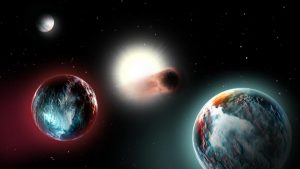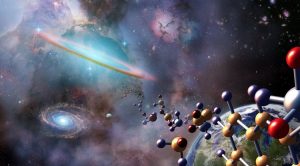Media
Transcript
Today’s news tells us a story of astronomers focusing on other worlds, and given the reality of the non-astronomy news I’ve read so far, I think we can all agree that other planets – particularly those far far away – seem particularly appealing at the moment.
But while we may all occasionally wish we could ship off to another planet, I’d warn you to be careful what you wish for, because not every world is habitable, and some worlds are actually under attack by their stars. A new paper appearing in the Monthly Notices of the Royal Astronomical Society gives us one particular example of just how bad it can get. In a study of the 25 million-year-old, Sun-like star V1298, scientists led by Katja Poppenhäger of the Leibniz-Institut Für Astrophysik in Potsdam have documented the horrific x-ray radiation that is blasting four young planets.

Young stars rotate very rapidly, and this rotation drives powerful magnetic fields. As the stars age, a variety of different processes cause them to slow down, which in turn reduces the magnetic field levels. According to this new research, exactly how long that takes can define the fates of worlds. Currently, V1298 is observed to have four large planets – two are Neptune-like and near their star, and two are more Saturn-like and further out. At least this is how they appear today. Using the Chandra X-Ray Observatory, scientists have observed current levels of x-ray emission capable of stripping the planets’ atmospheres away. If these strong magnetic fields and their x-ray emissions last too long, they will reduce the inner planets to lumps of rock, which admittedly could be understood as rocky worlds like Earth or even Mercury. The outermost and largest planet should be able to hold onto its atmosphere, but the fate of the middle gas giant is unknown as its mass still isn’t accurately determined.
This research raises some interesting questions about the horrific childhood of young planets. As stars rage against world atmospheres, they may be able to transform gas giants and ice giants into terrestrial planets. This changes how we view planet formation and may even change how we look at worlds in our own solar system. As we mentioned, V1298 is a sun-like star in the making. Its ice giants could be terrestrial worlds in the making. We don’t know – not yet – but this is the kind of question we need to consider as we try to define how solar systems form.
Understanding solar system formation is one of the most complex problems of interest today, and it requires understanding so much more than just a star and its worlds: it requires understanding the evolution of our universe. Worlds like our own require the clouds of dust and gas our solar system once was to contain all the chemistry required for life. As we’ve often talked about, the universe started out with only hydrogen, helium, and trace amounts of lithium and beryllium. It is through complex nucleosynthesis in stars and in the environments of explosively dying and merging stars, that everything else is formed. That gold you wear? That probably came from a neutron star merger. The platinum inside your cell phone? It may have originated in a supernova. Even the carbon that makes up so much of our body came from regular stars undergoing nuclear reactions in their cores.
While astronomers have long understood the need for heavy elements to form to get planets and subsequently life, the history of complex molecules needed for life has remained more mysterious, with folks working to create necessary molecules in labs that simulate the conditions on a young planet, and astronomers looking at the material between the stars to see what already exists. Now, in a new paper in the Astrophysical Journal, we learn that methanol and acetaldehyde exist in molecular clouds in regions where stars have not yet started to form.

Thirty-one dense regions, called starless cores, were observed, and all thirty-one had methanol while seventy percent contained acetaldehyde. Some of these cores may someday collapse to form stars, but their fate isn’t set and this research tells us what systems look like before solar system formation really gets started. According to study co-author Yancy Shirley, “This tells us that the basic organic chemistry needed for life is present in the raw gas prior to the formation of stars and planets.” What chemistry led to the formation of these organic compounds is unknown.
According to lead author Samantha Scibelli: Inside these cores, which we think of as birthplaces, cocoons, and nurseries of low-mass stars similar to our sun, the conditions are such that it’s hard to even create these molecules. By doing surveys like this, we can understand better how precursors to life come into existence, how they migrate and enter solar systems at later stages of star formation.
While this research still doesn’t tell us how these molecules form, it does tell us they don’t need to form during solar system formation, essentially kicking the problem back in time. It also helps us understand just what the birthplace of our solar system could have looked like. Scibelli explains it as follows: Our solar system was born in a cloud like this, but the cloud is not there anymore for us to see. Looking at objects in space is a bit like looking at a photo album with snapshots taken of different people at different stages of life, from their baby days all the way to old age, and in our case, starless cores serve as stellar sonograms.
Even though we still don’t have a firm grasp of how solar systems form, there are those ready to jump out and try and define how often life must form. We anticipate the next press release we’re going to discuss is going to lead to a lot of click-bait headlines, and we’re bringing it up so we can critically discuss what this story means.

In a new paper in the Astrophysical Journal, researchers led by Christopher Conselice describe their latest calculations of how many potentially communicating, technologically advanced civilizations may exist in our universe. According to the press release, the number is thirty-six, which strikes us as a bit overly precise. To be fair, the actual paper offers error bars, saying there should be 36 +175 or -32 civilizations. They also give a sound mathematical description of where this estimate comes from. This team used what I would describe as a simplified version of of the famous Drake equation, and asks “how many worlds have had the needed five billion years, or more broadly 4.5-5 billion years to evolve life?” and then assumes each of these civilizations will be detectable from their communications for a hundred years.
This simple “has it been around long enough, and is it likely in that 100-year window” calculation considers how many stars have planets and how long those stars have been around and essentially assumes that if a world forms, it will evolve life. This is a somewhat large assumption, and really, I personally like the Drake equation’s more nuanced approach that considers how likely it is for a society to kill itself off and other more complicated ideas, but if life does find a way and it typically takes 4.5 to 5 billion years, we now know how many planets could be out their spewing radio signals into space. Unfortunately, given the volume of the galaxy, they are likely no closer than 17,000 light-years away, and we will never hear them. If a civilization exists out of earshot, does it still make a signal?
Today’s news isn’t entirely satisfying. We now know in greater detail how baby stats try to pull apart planetary atmospheres, but we don’t know just what this means for the later formation of planets. We now know some of the molecules for life existed before solar systems got started, but we still don’t know where they come from. We have a new possible calculation of how likely it is that we’re alone, but it is based on huge assumptions. This is messy and somewhat unsatisfying, but this is the story of science; most of the time things just advance one incremental step at a time, and some of those steps are sideways, and occasionally they are missteps that carry us backwards. Overall, however, our understanding is growing, and we are making progress in understanding this wild universe that exists beyond our atmosphere.
For now, none of these distant worlds are ours. We’ve only got this one, so let’s do what we can to keep things moving forward here so that someday we will be able to move out among the stars.
Learn More
Four newborn exoplanets get cooked by their sun
- Leibniz Institute for Astrophysics Potsdam press release
- “X-ray Irradiation and Evaporation of the Four Young Planets Around V1298 Tau,” K. Poppenhaeger, L. Ketzer & M. Mallonn, 2020 May 30, Monthly Notices of the Royal Astronomical Society (Preprint on arxiv.org)
Ingredients for Life Appear in Stellar Nurseries Long Before Stars are Born
- The University of Arizona news release
- “Prevalence of Complex Organic Molecules in Starless and Prestellar Cores within the Taurus Molecular Cloud,” Samantha Scibelli & Yancy Shirley, 2020 March 5, Astrophysical Journal (Preprint on arxiv.org)
Research sheds new light on intelligent life existing across the Galaxy
- The University of Nottingham press release
- “The Astrobiological Copernican Weak and Strong Limits for Extraterrestrial Intelligent Life,” Tom Westby & Christopher J. Conselice, 2020 June 15, Astrophysical Journal (Preprint on arxiv.org)
Credits
Written by Pamela Gay
Hosted by Pamela Gay
Audio and Video Editing by Ally Pelphrey
Content Editing by Beth Johnson
Intro and Outro music by Kevin MacLeod, https://incompetech.com/music/


 We record most shows live, on Twitch. Follow us today to get alerts when we go live.
We record most shows live, on Twitch. Follow us today to get alerts when we go live.